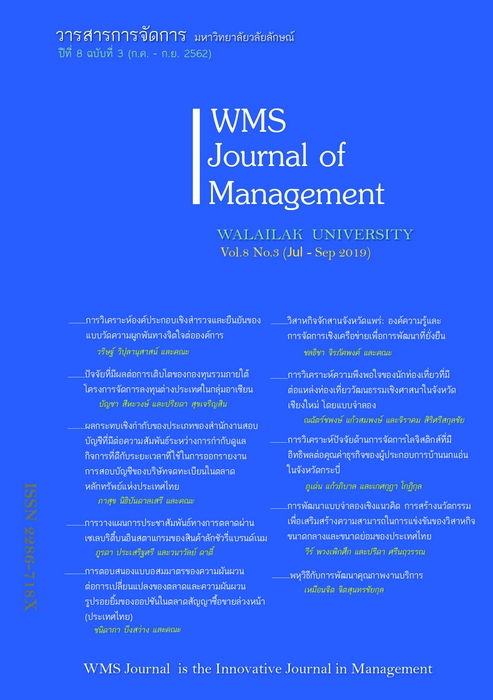An Analysis of Factors in Logistics Management Influencing Business Value of Swiftlet Nest Entrepreneurs in Krabi Province Analysis
Main Article Content
Abstract
The purpose of this research was to investigate factors in Logistics Management that influenced the business value of swiftlet nest entrepreneurs in Krabi Province.To collect data, questionnaires were distributed to 148 swiftlet nest entrepreneurs. Statistics for data analysis was descriptive statistics and multiple regression analysis which was used to test the relations among the variables. The findings show that
Regarding to logistics activities, swiftlet nest entrepreneurs placed importance on waste disposal. Transportation and packaging were ranked as the second place. With respect to the business value, productivity increasing and sustainable entrepreneurship were the first priority. Moreover, it was found that four independent variables namely packaging, order processing, customers’ demand forecasting and purchasing positively affected the business value. On the other hand, two independent variables namely transportation and inventory management negatively affected the business value at a significance level of 0.05.
Article Details
References
Boonlar, T., & Nimitpholol, N.(2012). kānčhatkān lōčhittik : miti sap phlāi chēn phāktritsadī læ patibat [Logistics Management: A Supply Chain Perspective]. Bangkok, Thailand: Se-education.
Chartered Institute of Logistics and Transport. (2016). Retrieved from http://www. ciltuk.org.uk/pages/home
Choe, M. F., & Kong, B. (2011). Logistics as a strategic role for the creation of Customer Value. (Master’s Thesis, Linnaeus University).
Council of Supply Chain Management. (2016). Retrieved from http://www.cscmp.org
Hair, J. F., Black, W. C., Babin, B. J., & Anderson, R. E. (2010). Multivariate data analysis (7th ed.). NJ: Pearson Education.
Hesket, J. L., Glaskowsky, N., & Ivie, R. M. (1973). Business Logistics. NY: The Ronald Press.
Hills, A. M. (2008). Foolproof guide to statistics using SPSS. Melbourne, Victoria, Australia: Council of Supply Chain Management: Pearson Education.
Jandam, K. (2107). chāttiphan rangnok ʻĒchīa tawanʻō̜k chīang tai [Bird’s nests, business, and ethnicity in Southeast Asia]. Bangkok, Thailand: The Thailand Research Fund (TRF).
Kasikornresearch. (2018). rangnok nāngʻǣn : khāwīa hǣng tawanʻō̜k thō̜ngkhamkhāo hǣng thō̜ng thale [Bird’s nests: Carviar of the East platinum of the sea]. Retrieved from http://www.acfs.go.th
Krabi Provincial Livestock Office (2015) Retrieved from http://pvlo-kbi.dld.go.th
Ministry of commerce. (2015). sathiti kānkhā rawāng prathēt khō̜ng Thai [Thailand Trade Statistics]. Retrieved from http://www2.moc.go.th
National bureau of agricultural commodity and food standards. (2014). māttrathān sinkhā kasēt : rangnok [Thai agricultural standards: Bird’s nest]. Retrieved from http://www2.moc.go.th
Natural Resources and Environmental Crime Division (2018). anusanyā saitēt [CITES]. Retrieved from http://www.nepolice.go.th
Ongombe, J. (2012). Reverse logistics and competitive advantage: An investigation of water bottling companies in Nairobi. (Masters’s Thesis, University Of Nairobi).
Ozer, O. (2011). Inventory Management: Information, Coordination and Rationality. Retrieved from https://ssrn.com/abstract=1351628
Qi, Y., Zhao, X., & Sheu, C. (2011). The impact of competitive strategy and supply chain strategy on business performance: The role of environmental uncertainty. Decision Sciences, 42(2), 371-389.
Rutner, S. M., & Langley Jr, C. J. (2000). Logistics value: definition, process and measurement. The International Journal of Logistics Management, 11(2), 73-82.
Susanto, T., Djamaris, A. R., & Azkia, N. (2016). Process Analysis on Order Processing Function to Reduce Order Processing Time. International Journal of Research in Management & Technology, 6(3), 76-89.
Thoucharee, S., & Junwiang, W. (2014). khrōngsāng tonthun lōčhittik khō̜ng kasēttrakō̜n phū plūk thurīan nai khēt čhangwat čhanthaburī [Logistics cost structure for farmer of durain in Chanthaburi province]. KKU Research Journal, 19(2), 344-353.
Waters, C. D. J. (2003). Logistics: An introduction to supply chain management. NY: Palgrave Macmillan.
Zhou, X. (2013). Research on Logistics Value Chain Analysis and Competitiveness Construction for Express Enterprises. American Journal of Industrial and Business Management, 3(2), 131.


